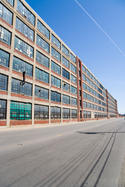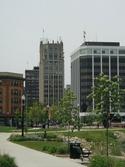Back in the 1980s, Citibank CEO John S. Reed looked at the bank’s earnings and said, more or less: This is really a credit card company with six other lines of business. That is, the card portfolio was making lots of dough, and carrying the rest. Commercial lending, real estate lending, clearing, foreign exchange, branch banking — all of them were flat or losing money, while the card business was cooking. read more »
Here in the Real World They’re Shutting Detroit Down
Once upon a time, not so long ago, in a city at the heart of the American continent, General Motors produced cars, like Pontiac’s “Little GTO,” celebrated in Beach Boys songs that captured the thrill of driving Detroit’s latest creations. Today, as GM struggles to appease the government’s auditors just to stay alive, Kris Kristofferson, with a little help from Mickey Rourke, curses the financial wizards from Wall Street that are “Shutting Detroit Down” while “livin’ it up in that New York town.” read more »
The Worst Cities for Job Growth
One of the saddest tasks in the annual survey of the best places to do business I conduct with Pepperdine University's Michael Shires is examining the cities at the bottom of the list. Yet even in these nether regions there exists considerable diversity: Some places are likely to come back soon, while others have little immediate hope of moving up. (Please also see "Best Cities For Job Growth" for further analysis.)
The study is based on job growth in 336 regions – called Metropolitan Statistical Areas by the Bureau of Labor Statistics, which provided the data – across the U.S. Our analysis looked not only at job growth in the last year but also at how employment figures have changed since 1996. This is because we are wary of overemphasizing recent data and strive to give a more complete picture of the potential a region has for job-seekers. (For the complete methodology, click here.)
Germany's Green Energy Goals Are Potentially Unrealistic
The world looks to Germany to be a leader in Green Energy. There’s been a great deal of hype surrounding Chancellor Angela Merkel’s very ambitious goals of dramatically reducing the county’s emissions by 2020.
Yet the German experience should also provide some pause to President Obama and others proposing such changes in the United States. It turns out that goals are potentially unrealistic, perhaps even dangerous, for numerous reasons. read more »
Is That an Economic Light at the End of the Tunnel or an Oncoming Train?
When it comes to the state of the economy, is the worst behind us or still to come? Informed opinion is all over the map. The optimists are citing such factors as accommodative Federal Reserve Bank policy (massively increased liquidity), bank profitability (and yes, banks are lending, but only quality loans), money velocity (trending up), a positive yield curve (long-term vs. short-term rates), housing starts (surging), favorable financial rule changes (abandonment of mark-to-market accounting, reinstatement of the short uptick rule to prevent naked short-selling), retail sales (recovering), commodity prices (rising due to increased industrial demand), used car prices (firming), and new vehicle sales (rising off their sickening lows). read more »
- Login to post comments
Mr. Cloghessy Deserves Better – And So Do the Rest of Us
The role of politicians in the corruption of our civic spirit – a national problem that has led us to the current economic mess – has me thinking a lot about Joe Cloghessy.
Mr. Cloghessy lived in my childhood neighborhood. He was big and strong and worked hard for a living, like most of the men in the neighborhood. He might have had more money than his neighbors, but that never came up. He did have a pool in his backyard – he built it himself – and that made his house a rarity in those parts. read more »
Playing With Trains
The Obama administration appears to have established the development of high speed rail (HSR) as the most important plank of its transportation strategy. The effort may be popular with the media and planners, but it’s being promoted largely on the basis of overstatement and even misinformation. read more »
Can Eddie Mac Solve the Housing Crisis?
Every downturn comes to an end. Recovery has followed every recession including the Great Depression. In 1932, John D. Rockefeller said, "These are days when many are discouraged. In the 93 years of my life, depressions have come and gone. Prosperity has always returned and will again." The question is not ”IF”, rather it is “WHEN” recovery will begin. The age-old question remains: what can government do to get the nation out of recession?
Government can act wisely. In the past, it used tax legislation (the mortgage interest deduction) to create the highest home ownership rate in the industrialized world. It can also act stupidly by promoting “Sub-Prime” mortgages, “105%” financing and the “No-Doc” loan that got us into this financial mess. As many as 4.4 million more Americans could lose their homes – unless drastic action is taken to stop the process. read more »
Solving the Economic Crisis: Fix the Banks
Economic forecasts today reflect a remarkable variation. Some economists are predicting a rapid increase in economic activity within just a few months. Some are forecasting an economic decline that persists for years.
At the root of the debate lies the question: where is the heart of darkness? Primarily, forecasters are focusing on the impact of the fiscal stimulus and the efficacy of monetary policy. Yet they have been less forthcoming to center on the real problem, which is fixing the banks. read more »
Entrepreneurs Overlooked in Recovery Plans
As most recently spelled out in The Economist , one of America’s most potent advantages – even in the current economic crisis – lies in its entrepreneurialism. America’s entrepreneurs are the proverbial wellspring of innovation and creators of most of the country’s new economic opportunities. Entrepreneurs, or global heroes as The Economist calls them, are not only important here in this country but are the best hope for creating the innovations that will get sufficient traction to resuscitate the world economy. read more »






















